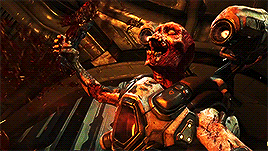Review: DOOM (2016)
3rd May 2017By Sam Wilkinson
The world-renowned first person shooter DOOM has just released another title into its franchise. Created by Id software and Bethesda Softworks, it was critically acclaimed by critics and customers alike with the game receiving the ‘Best Action Game’ and the ‘Best Music Design’ of 2016. Many people even went on to say that it was the game of the year.
The newest game in the series was originally expected to follow the traditional naming conventions and would be called DOOM 4 but as more details were revealed it would turn out to be just called DOOM, suggesting that the next game would be a re-boot to the series after the changes that were implemented in DOOM 3.
As with the other games in the franchise, 2016’s DOOM is more on the light side of a narrative story. It’s set on the planet of Mars where humans have opened a portal to Hell and have began research into converting “Hell energy” into something mankind can benefit from. The main protagonist of the game starts out by escaping from his tomb that was recovered from a temple within Hell, and an invasion in the place awakens the protagonist and the rest of the game is spent figuring out how to close the Hell portal… Phew.

DOOM 3 was an interesting turn in the franchise as it made the move to a slower paced game with more horror elements than older DOOM games. The game was still well praised but it didn’t have the same effect on the player that they got from the original. Id software and Bethesda realised this wasn’t the direction the fans wanted to go and decided the next game would be more like the original. But fans would have to wait nearly 10 years for the next iteration of the franchise as DOOM 4 was stuck in a development cycle of planning, production, then scrapping production halfway through and then planning again, aptly known as “Development Hell”.
Among the current generation of first person shooters, such as the Call of Duty and Battlefield series which prefer to take a slower pace to their combat, and ground their games in realism, DOOM stands out with its fast paced action and hefty amount of violence thrown into the mix. DOOM adds verticality to its combat by designing the levels with multiple layers for different angles of attack on enemies. DOOM may not feature the largest amount of weapon variety or customisation compared to Call of Duty or Battlefield, but they are certainly memorable – from the super shotgun to the BFG 9000 – and the weapons in DOOM are enjoyable to use. The combat allows for close, medium and long-range engagements with varying enemy types for users to defeat.
2016’s DOOM features a multiplayer mode as well as a map creation system called ‘Snap Map’. The multiplayer comprises of many different game modes but the classic death match mode is the most popular choice. The multiplayer brings back the early days of gaming over the Internet with the game feeling like Unreal Tournament from the early 2000s with the combat being simple compared to other shooter titles such as the Battlefield series which prides itself on being more of a complex game.
The in-game map creation system dubbed ‘Snap Map’ by the developers allows players on all gaming platforms to design and create their own levels on the DOOM engine, similar to the forge mode seen in the Halo series. The developer’s choice to allow players to create their own levels produces a theoretically infinite amount of gameplay available and the players have used this to their advantage as some have managed to create games within the Snap Map, such as a working MOBA prototype, a working music synthesiser and a recreation of the super Nintendo’s Harvest Moon.


